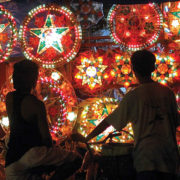While the days leading to Christmas Day are usually festive, there is no denying that this season makes one wistful and sentimental. I recently received a message from a relative who moved to the U.S. from the Philippines earlier this year.
She said she was feeling homesick and that the American Christmas season is not as merry as compared to how Filipinos celebrate it back home.
I’m sure many Filipinos who are abroad share the same feeling. But, wherever you are, you need to remember that Christmas is the most wonderful time of the year. While you may not be able to celebrate it in the Philippines this year, remember that there’s always a next year.
To help you plan your next Christmas vacation, here are some reasons why celebrating the holidays back home is worth your week-long or month-long vacation leave.
Kids singing your favorite Christmas carols
I remember being ecstatic every time December hits the calendar. Because it is during this time you would hear kids sing well-loved Christmas songs such as “Ang Pasko Ay Sumapit”, “Pasko Na Naman”, “Christmas In Our Hearts”, “Jingle Bells” and many more.
Simbang Gabi (dawn Masses)
Christmas season in the Philippines begins early as the month of September. These nine-day traditional dawn Masses start on December 16 and end on Christmas Day. Some say, that completing the Simbang Gabi—by attending all nine Masses—will grant wishes.
Puto bumbong and bibingka
A perfect way to cap your early morning habit during the Simbang Gabi is to treat yourself to a warm soft and chewy treat by eating puto bumbong and bibingka! Bibingka is made from galapong (rice dough), baked in a special clay pot, lined with a piece of banana leaf, with live coals on top and underneath. Puto bumbong meanwhile is a made from purple-colored ground rice cooked in bamboo tubes that are placed on a custom-made steamer-cooker. These Filipino treats are best paired with hot chocolate.
Creative parols (lanterns)
Filipino Christmas is lively and colorful. This is why during this season, bright and twinkling parols (lanterns) adorn almost every house in the country. The parol represents the star of Betlehem which guided the Three Wise Men to the manger of the newly-born Jesus Christ.
Belen (nativity scene)
Aside from the parols, another popular decoration in the Philippines during Christmas season is the belen (nativity scene). The belen depicts the Holy Family during the birth of Jesus Christ, displayed mostly at churches, homes, schools, and various establishments.
Noche Buena
Celebrations aren’t complete without a gathering of family and friends over a sumptuous meal. This is what Noche Buena (Christmas eve dinner) is all about—togetherness, love, and gratitude. Who can resist that sparkly lechon (roasted pig), the once a year hamon (ham), and the creamy queso de bola (ball cheese), the sweet Pinoy-style spaghetti and the much-loved barbeque, anyway?
Receive and give gifts
As a kid who grew up in the Philippines, Christmas was (and still is, I think) my favorite time of the year. Back then, I always received more gifts during Christmas than I do on my birthday, which happens to be a couple of weeks before Christmas.
People are happier and are most generous during this time of the year. As a little kid, I kept on thinking that this is Jesus’ manifestation of love for me; that instead of Him receiving gifts for His birthday, He just let me gave them all—regardless if I was naughty or nice that year.
As I grew older, I learned that gift-giving is deeply inculcated in the Filipinio Christmas tradition, especially when you are a ninong/ninang (godfather/godmother).
Sociologist Niño Tobias told Inquirer that, “Filipinos have the propensity to be more generous, especially during Christmas.”
“Hospitality is a way of sharing yourself with other people. We enjoy giving, that’s why Christmas in the Philippines is exaggerated. You see, even the poor will spend just so he can give,” said Tobias.
“We want to make other people happy. This trait, which is primarily reflected by our hospitality culture, trickles down to how we celebrate the holiday season,” he added.







